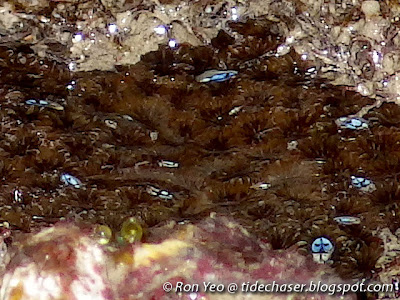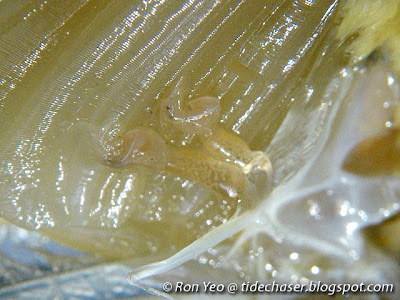Barnacles (phylum Arthropoda, subphylum Crustacea, class Maxillopoda, infraclass Cirripedia) are most easily seen on the upper shores, where they appear like miniature volcanoes attached to rocks and other hard structures.
They may resemble limpets (which are molluscs), but they are crustaceans, most obvious in their larva stage when they superficially resemble small shrimps with a segmented body and jointed legs. The larva eventually finds a suitable substrate and attaches itself permanently to it with a cement-like substance it produces, and secretes a conical shell around it. There is a hole at the top of the shell (hence appearing like a miniature volcano), which allows the animal to extend its hairy appendages to filter plankton from the water during high tide. During low tide, the animal will hide in the shell and block the opening with a trapdoor-like operculum.
Not all barnacles have this volcano-like appearance, and some species are stalked - appearing somewhat like a germinating seed. These are often called goose barnacles as some species resemble the head and neck of a goose (with some imagination), and may attach to rocks or flotsam.
Some barnacles are parasitic, and are found attached to the gills or other internal parts of other animals. These crustaceans have lost their legs and shells, and feed on the tissues of the hosts. Some parasitic barnacles may damage the reproductive systems of their hosts.
Most barnacles are hermaphroditic, and being sessile makes sexual reproduction a challenge. These barnacles have thus developed very long penises which extend out of their shells to fertilise other neighbouring barnacles. It is believed that barnacles probably have the longest penises relatively to the body size in the animal kingdom. For some species that have separate sexes, a tiny male often lives within the shell of a much larger female to make fertilisation easier. The fertilised eggs will hatch into planktonic larvae.
As barnacles tend to stick to any hard surfaces, including marine vessels and port structures, they are often viewed as a problem in the maritime industry (readers of the comic series Tin Tin will remember Captain Haddock cursing, "Billions of bilious blue blistering barnacles!"). Barnacles that grow on marine vessels add weight and slow down them down, while those that grow on maritime equipment may cause them to malfunction, or make them difficult to handle as the edges of these barnacles can be quite sharp, causing cuts and blisters. The research on reducing barnacle growth is hence a huge industry itself.
Some of the bigger barnacle species are consumed by human.
Several groups/species of barnacles can be found in Singapore, though the ones I have photographed so far are all from the superorder Thoracica. Members of this order may be sessile (stuck to hard surfaces in conical shells) or stalked.
A) Order Sessilia
This order comprises the sessile barnacles which secrete a conical shell permanently stuck to a hard surface. They normally feed by actively waving their "hairy" appendages during high tide to filter food particles from the water column.

Volcano Barnacles (Tetraclita sp.) form hard, conical shells. The thick wall of the shell has numerous holes and gaps internally (much like a sponge!), holding many pockets of air for heat insulation. The width of the barnacle can get to about 3cm. It is often found on huge rocks, and unlike most of the other species below, does not usually occur in huge clusters.

Star Barnacles (Euraphia sp.) has a star-like appearance, and are usually not more than 1cm wide. They often occur high up on the shore, forming huge clusters on areas above the other barnacles.

Acorn Barnacles (Balanus sp.) are possibly the most commonly seen barnacles. They often form a continuous layer on rocks and other hard structures on the high shore.

Acorn Barnacles can also be found growing on the shells of other living things, such as the ones above growing on the shell of a crab hiding under the sand.

Here is another example of Acorn Barnacles growing on the exoskeleton of a crab.

Many species of barnacles from the family Pyrgomatidae, Megabalanidae and Balanidae are known to embed themselves in corals. They are commonly called Coral Barnacles, and can be differentiated by the number of calcareous shell plates they posses. These plates, however, can only be examined if the specimen is removed from the coral host, and hence identification is usually hard in the field. The unidentified species featured in the above picture has a bluish coloration, and the specimens are embedded in a coral of the family Faviidae.

This unidentified species appeared to have gained some control over the hard coral's calcification ability, as the corallites which they are embedded in are much larger than the unaffected surrounding ones. The host coral appears to be of the family Faviidae.
B) Order Pedunculata
This order comprises barnacles that are attached to surfaces via a flexible stalk. Unlike the previous group, they are dependent on water movement to filter food particles, and generally do not actively move their "hairy" appendages.

Commensal Goose Barnacles (Octolasmis sp.) are sometimes found attached to the gills of crustaceans. They do not cause much harm to the host, but are just hitching a ride and benefiting from the water currents created by the gills, which bring plankton and other suspended food particles. However, when the crustacean hosts moult, these barnacles will be discarded with the old exoskeleton.
References
They may resemble limpets (which are molluscs), but they are crustaceans, most obvious in their larva stage when they superficially resemble small shrimps with a segmented body and jointed legs. The larva eventually finds a suitable substrate and attaches itself permanently to it with a cement-like substance it produces, and secretes a conical shell around it. There is a hole at the top of the shell (hence appearing like a miniature volcano), which allows the animal to extend its hairy appendages to filter plankton from the water during high tide. During low tide, the animal will hide in the shell and block the opening with a trapdoor-like operculum.
Not all barnacles have this volcano-like appearance, and some species are stalked - appearing somewhat like a germinating seed. These are often called goose barnacles as some species resemble the head and neck of a goose (with some imagination), and may attach to rocks or flotsam.
Some barnacles are parasitic, and are found attached to the gills or other internal parts of other animals. These crustaceans have lost their legs and shells, and feed on the tissues of the hosts. Some parasitic barnacles may damage the reproductive systems of their hosts.
Most barnacles are hermaphroditic, and being sessile makes sexual reproduction a challenge. These barnacles have thus developed very long penises which extend out of their shells to fertilise other neighbouring barnacles. It is believed that barnacles probably have the longest penises relatively to the body size in the animal kingdom. For some species that have separate sexes, a tiny male often lives within the shell of a much larger female to make fertilisation easier. The fertilised eggs will hatch into planktonic larvae.
As barnacles tend to stick to any hard surfaces, including marine vessels and port structures, they are often viewed as a problem in the maritime industry (readers of the comic series Tin Tin will remember Captain Haddock cursing, "Billions of bilious blue blistering barnacles!"). Barnacles that grow on marine vessels add weight and slow down them down, while those that grow on maritime equipment may cause them to malfunction, or make them difficult to handle as the edges of these barnacles can be quite sharp, causing cuts and blisters. The research on reducing barnacle growth is hence a huge industry itself.
Some of the bigger barnacle species are consumed by human.
Several groups/species of barnacles can be found in Singapore, though the ones I have photographed so far are all from the superorder Thoracica. Members of this order may be sessile (stuck to hard surfaces in conical shells) or stalked.
A) Order Sessilia
This order comprises the sessile barnacles which secrete a conical shell permanently stuck to a hard surface. They normally feed by actively waving their "hairy" appendages during high tide to filter food particles from the water column.

Volcano Barnacles (Tetraclita sp.) form hard, conical shells. The thick wall of the shell has numerous holes and gaps internally (much like a sponge!), holding many pockets of air for heat insulation. The width of the barnacle can get to about 3cm. It is often found on huge rocks, and unlike most of the other species below, does not usually occur in huge clusters.

Star Barnacles (Euraphia sp.) has a star-like appearance, and are usually not more than 1cm wide. They often occur high up on the shore, forming huge clusters on areas above the other barnacles.

Acorn Barnacles (Balanus sp.) are possibly the most commonly seen barnacles. They often form a continuous layer on rocks and other hard structures on the high shore.

Acorn Barnacles can also be found growing on the shells of other living things, such as the ones above growing on the shell of a crab hiding under the sand.

Here is another example of Acorn Barnacles growing on the exoskeleton of a crab.

Many species of barnacles from the family Pyrgomatidae, Megabalanidae and Balanidae are known to embed themselves in corals. They are commonly called Coral Barnacles, and can be differentiated by the number of calcareous shell plates they posses. These plates, however, can only be examined if the specimen is removed from the coral host, and hence identification is usually hard in the field. The unidentified species featured in the above picture has a bluish coloration, and the specimens are embedded in a coral of the family Faviidae.

This unidentified species appeared to have gained some control over the hard coral's calcification ability, as the corallites which they are embedded in are much larger than the unaffected surrounding ones. The host coral appears to be of the family Faviidae.
B) Order Pedunculata
This order comprises barnacles that are attached to surfaces via a flexible stalk. Unlike the previous group, they are dependent on water movement to filter food particles, and generally do not actively move their "hairy" appendages.

Commensal Goose Barnacles (Octolasmis sp.) are sometimes found attached to the gills of crustaceans. They do not cause much harm to the host, but are just hitching a ride and benefiting from the water currents created by the gills, which bring plankton and other suspended food particles. However, when the crustacean hosts moult, these barnacles will be discarded with the old exoskeleton.
References
- Achituv, Y. & N. Simon-Blecher. 2006. Pyrgopsella (Cirripedia: Balanomorpha: Pyrgomatidae) is not a sponge-inhabiting barnacle. Zootaxa (1319): 29-41.
- Burnie, D. 2001. Animal. London: Dorling Kindersley. 624 pp.
- Debelius, H. 1999. Crustacea - Guide of the world. IKAN, Frankfurt. 321pp.
- Ng, P. K .L., R.T. Corlett & H.T.W. Tan (eds.). 2011. Singapore Biodiversity: An Encyclopedia of the Natural Environment and Sustainable Development. Singapore: Editions Didier Millet. 552 pp.
- Ng, P. K. L., S. S. L. Lim, L. K. Wang & L. W. H. Tan. 2007. Private lives: An exposé of Singapore's shores. The Raffles Museum of Biodiversity Research, Department of Biological Sciences, National University of Singapore. 212 pp.
- Simon-Blecher, N., D. Huchon & Y. Achituv. 2007. Phylogeny of coral-inhabiting barnacles Cirripedia; Thoracica; Pyrgomatidae based on 12S, 16S and 18S rDNA analysis. Molecular Phylogenetics and Evolution 44(3): 1333-1341

No comments:
Post a Comment